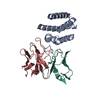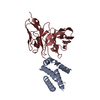[English] 日本語
 Yorodumi
Yorodumi- PDB-9bhb: Cryo-EM structure of human monoclonal antibody C74 targeting PFD1... -
+ Open data
Open data
- Basic information
Basic information
| Entry | Database: PDB / ID: 9bhb | |||||||||||||||||||||||||||||||||||||||||||||||||||||||||
|---|---|---|---|---|---|---|---|---|---|---|---|---|---|---|---|---|---|---|---|---|---|---|---|---|---|---|---|---|---|---|---|---|---|---|---|---|---|---|---|---|---|---|---|---|---|---|---|---|---|---|---|---|---|---|---|---|---|---|
| Title | Cryo-EM structure of human monoclonal antibody C74 targeting PFD1235w (CIDRa1.6) PfEMP1 | |||||||||||||||||||||||||||||||||||||||||||||||||||||||||
 Components Components |
| |||||||||||||||||||||||||||||||||||||||||||||||||||||||||
 Keywords Keywords | IMMUNE SYSTEM / Antibody / Plasmodium / Monoclonal / Neutralizing | |||||||||||||||||||||||||||||||||||||||||||||||||||||||||
| Function / homology |  Function and homology information Function and homology informationsymbiont-mediated perturbation of host erythrocyte aggregation / infected host cell surface knob / antigenic variation / adhesion of symbiont to microvasculature / cell adhesion molecule binding / cell-cell adhesion / host cell surface receptor binding / host cell plasma membrane / membrane Similarity search - Function | |||||||||||||||||||||||||||||||||||||||||||||||||||||||||
| Biological species |  Homo sapiens (human) Homo sapiens (human) | |||||||||||||||||||||||||||||||||||||||||||||||||||||||||
| Method | ELECTRON MICROSCOPY / single particle reconstruction / cryo EM / Resolution: 3.1 Å | |||||||||||||||||||||||||||||||||||||||||||||||||||||||||
 Authors Authors | Raghavan, S.S.R. / Ward, A.B. | |||||||||||||||||||||||||||||||||||||||||||||||||||||||||
| Funding support |  United States, United States,  Denmark, 2items Denmark, 2items
| |||||||||||||||||||||||||||||||||||||||||||||||||||||||||
 Citation Citation |  Journal: Nature / Year: 2024 Journal: Nature / Year: 2024Title: Broadly inhibitory antibodies to severe malaria virulence proteins. Authors: Raphael A Reyes / Sai Sundar Rajan Raghavan / Nicholas K Hurlburt / Viola Introini / Sebastiaan Bol / Ikhlaq Hussain Kana / Rasmus W Jensen / Elizabeth Martinez-Scholze / María Gestal-Mato ...Authors: Raphael A Reyes / Sai Sundar Rajan Raghavan / Nicholas K Hurlburt / Viola Introini / Sebastiaan Bol / Ikhlaq Hussain Kana / Rasmus W Jensen / Elizabeth Martinez-Scholze / María Gestal-Mato / Borja López-Gutiérrez / Silvia Sanz / Cristina Bancells / Monica Lisa Fernández-Quintero / Johannes R Loeffler / James Alexander Ferguson / Wen-Hsin Lee / Greg Michael Martin / Thor G Theander / John P A Lusingu / Daniel T R Minja / Isaac Ssewanyana / Margaret E Feeney / Bryan Greenhouse / Andrew B Ward / Maria Bernabeu / Marie Pancera / Louise Turner / Evelien M Bunnik / Thomas Lavstsen /    Abstract: Malaria pathology is driven by the accumulation of Plasmodium falciparum-infected erythrocytes in microvessels. This process is mediated by the polymorphic erythrocyte membrane protein 1 (PfEMP1) ...Malaria pathology is driven by the accumulation of Plasmodium falciparum-infected erythrocytes in microvessels. This process is mediated by the polymorphic erythrocyte membrane protein 1 (PfEMP1) adhesion proteins of the parasite. A subset of PfEMP1 variants that bind to human endothelial protein C receptor (EPCR) through their CIDRα1 domains is responsible for severe malaria pathogenesis. A longstanding question is whether individual antibodies can recognize the large repertoire of circulating PfEMP1 variants. Here we describe two broadly reactive and inhibitory human monoclonal antibodies to CIDRα1. The antibodies isolated from two different individuals exhibited similar and consistent EPCR-binding inhibition of diverse CIDRα1 domains, representing five of the six subclasses of CIDRα1. Both antibodies inhibited EPCR binding of both recombinant full-length and native PfEMP1 proteins, as well as parasite sequestration in bioengineered 3D human brain microvessels under physiologically relevant flow conditions. Structural analyses of the two antibodies in complex with three different CIDRα1 antigen variants reveal similar binding mechanisms that depend on interactions with three highly conserved amino acid residues of the EPCR-binding site in CIDRα1. These broadly reactive antibodies are likely to represent a common mechanism of acquired immunity to severe malaria and offer novel insights for the design of a vaccine or treatment targeting severe malaria. | |||||||||||||||||||||||||||||||||||||||||||||||||||||||||
| History |
|
- Structure visualization
Structure visualization
| Structure viewer | Molecule:  Molmil Molmil Jmol/JSmol Jmol/JSmol |
|---|
- Downloads & links
Downloads & links
- Download
Download
| PDBx/mmCIF format |  9bhb.cif.gz 9bhb.cif.gz | 90.4 KB | Display |  PDBx/mmCIF format PDBx/mmCIF format |
|---|---|---|---|---|
| PDB format |  pdb9bhb.ent.gz pdb9bhb.ent.gz | 59.7 KB | Display |  PDB format PDB format |
| PDBx/mmJSON format |  9bhb.json.gz 9bhb.json.gz | Tree view |  PDBx/mmJSON format PDBx/mmJSON format | |
| Others |  Other downloads Other downloads |
-Validation report
| Summary document |  9bhb_validation.pdf.gz 9bhb_validation.pdf.gz | 1.2 MB | Display |  wwPDB validaton report wwPDB validaton report |
|---|---|---|---|---|
| Full document |  9bhb_full_validation.pdf.gz 9bhb_full_validation.pdf.gz | 1.2 MB | Display | |
| Data in XML |  9bhb_validation.xml.gz 9bhb_validation.xml.gz | 24.9 KB | Display | |
| Data in CIF |  9bhb_validation.cif.gz 9bhb_validation.cif.gz | 33.2 KB | Display | |
| Arichive directory |  https://data.pdbj.org/pub/pdb/validation_reports/bh/9bhb https://data.pdbj.org/pub/pdb/validation_reports/bh/9bhb ftp://data.pdbj.org/pub/pdb/validation_reports/bh/9bhb ftp://data.pdbj.org/pub/pdb/validation_reports/bh/9bhb | HTTPS FTP |
-Related structure data
| Related structure data |  44539MC  8vdfC  8vdgC  8vdlC M: map data used to model this data C: citing same article ( |
|---|---|
| Similar structure data | Similarity search - Function & homology  F&H Search F&H Search |
- Links
Links
- Assembly
Assembly
| Deposited unit | 
|
|---|---|
| 1 |
|
- Components
Components
| #1: Antibody | Mass: 13441.013 Da / Num. of mol.: 1 Source method: isolated from a genetically manipulated source Source: (gene. exp.)  Homo sapiens (human) / Production host: Homo sapiens (human) / Production host:  |
|---|---|
| #2: Protein | Mass: 12178.488 Da / Num. of mol.: 1 Source method: isolated from a genetically manipulated source Source: (gene. exp.)  Homo sapiens (human) / Production host: Homo sapiens (human) / Production host:  |
| #3: Protein | Mass: 85069.266 Da / Num. of mol.: 1 Source method: isolated from a genetically manipulated source Source: (gene. exp.)   |
| Has protein modification | Y |
-Experimental details
-Experiment
| Experiment | Method: ELECTRON MICROSCOPY |
|---|---|
| EM experiment | Aggregation state: PARTICLE / 3D reconstruction method: single particle reconstruction |
- Sample preparation
Sample preparation
| Component | Name: Complex of human monoclonal C74 with PfEMP1 PFD1235w N-terminal domain complex Type: CELL / Entity ID: all / Source: RECOMBINANT |
|---|---|
| Source (natural) | Organism:  |
| Source (recombinant) | Organism:  |
| Buffer solution | pH: 7.5 |
| Specimen | Embedding applied: NO / Shadowing applied: NO / Staining applied: NO / Vitrification applied: YES |
| Specimen support | Grid material: GOLD / Grid mesh size: 300 divisions/in. |
| Vitrification | Instrument: FEI VITROBOT MARK IV / Cryogen name: ETHANE / Humidity: 95 % |
- Electron microscopy imaging
Electron microscopy imaging
| Microscopy | Model: TFS GLACIOS |
|---|---|
| Electron gun | Electron source:  FIELD EMISSION GUN / Accelerating voltage: 200 kV / Illumination mode: FLOOD BEAM FIELD EMISSION GUN / Accelerating voltage: 200 kV / Illumination mode: FLOOD BEAM |
| Electron lens | Mode: BRIGHT FIELD / Nominal defocus max: 2000 nm / Nominal defocus min: 800 nm |
| Image recording | Electron dose: 50 e/Å2 / Film or detector model: FEI FALCON IV (4k x 4k) |
- Processing
Processing
| EM software | Name: PHENIX / Category: model refinement |
|---|---|
| CTF correction | Type: PHASE FLIPPING AND AMPLITUDE CORRECTION |
| 3D reconstruction | Resolution: 3.1 Å / Resolution method: FSC 0.143 CUT-OFF / Num. of particles: 130000 / Symmetry type: POINT |
 Movie
Movie Controller
Controller





 PDBj
PDBj

